Translating to/from other languages using spoken/oral language is generally called interpretation. Depending on the size, purpose and setting of meetings, interpretation service falls into two distinct methods: Simultaneous and Consecutive.
What are the main differences between these two methods of interpreting?
Consecutive interpretation is DELAYED, with the interpreter taking in, notating, and then translating what has been said in “chunks”. The interpreter interprets after people speak, and may pause between chunks of spoken material, depending on their speed and ability, as well as the nature of the material being interpreted. This is the more common and less labor-intensive service of the two interpretation modes, and it is ideal for peer-to-peer communications, or for small meetings like parent-teacher conferences and IEP meetings. Because of its popularity and simplicity, consecutive interpreters’ availability is more consistently available and accessible when compared to simultaneous interpreters’. A school’s Bilingual Resource Specialists are good examples of staff who engage in consecutive interpretations for parents and school staff on a daily basis.
Simultaneous interpretation is an INSTANT interpretation of what is being said without any interruptions or pauses. Simultaneous interpretation is a more intensive/complex service, and it requires experienced interpreters with specialized equipment. Only LSRC-approved interpreters are assigned to simultaneous meetings, so interpreters’ availability is limited. Simultaneous interpretation in various languages is mostly used in major events where larger audiences listen to, for example, a keynote speaker speaking to an audience of stakeholders who require interpretation of different languages. Examples of events that require simultaneous interpretation are graduation ceremonies, public hearings, or school board meetings. Because of the effort required and intensity of simultaneous interpretation, two interpreters are required for sessions of more than two hours.
Simultaneous interpretation equipment [transmitter (Pic 1) and headsets (Pic 2)] is required for onsite meetings. In a virtual environment, simultaneous room enabled Zoom is required. For Teams meetings, please contact us for further instructions.
Pic 1 Pic 2
 Contact
Contact  Calendars
Calendars Careers
Careers Engage
Engage  District
District

